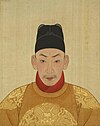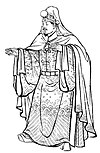List_of_emperors_of_the_Ming_dynasty
The Ming dynasty was a dynasty of China that existed from 1368 to 1644, succeeding the Mongol-led Yuan dynasty and falling amidst much political turmoil to the short-lived Shun dynasty. Sixteen emperors ruled over the whole of China proper spanning 276 years. Following the collapse of the Ming dynasty in 1644, members of the Ming imperial family continued to rule parts of southern China until 1662; this regime is known as the Southern Ming in historiography.
| Emperor of the Great Ming | |
|---|---|
| 大明皇帝 | |
Imperial | |
| Details | |
| Style | His Imperial Majesty (陛下, 皇上, 萬歲) |
| First monarch | |
| Last monarch |
|
| Formation |
|
| Abolition |
|
| Residence |
|
| Appointer | Hereditary |
| Portrait | Emperor (birth–death) |
Reign[1] | Personal name | Era name | Posthumous name | Temple name[lower-alpha 1] |
|---|---|---|---|---|---|---|
 |
Hongwu Emperor 洪武帝 (21 October 1328 – 24 June 1398) |
23 January 1368 – 24 June 1398 |
Zhū Yuánzhāng 朱元璋 |
Hóngwǔ 洪武 |
Emperor Gāo 高皇帝 |
Tàizǔ 太祖 |
 |
Jianwen Emperor 建文帝 (5 December 1377 – 13 July 1402) |
30 June 1398 – 13 July 1402 |
Zhū Yǔnwén 朱允炆 |
Jiànwén 建文 |
Emperor Ràng 讓皇帝 |
Huìzōng[lower-alpha 2] 惠宗 |
 |
Yongle Emperor 永樂帝 (2 May 1360 – 12 August 1424) |
17 July 1402 – 12 August 1424 |
Zhū Dì 朱棣 |
Yǒnglè 永樂 |
Emperor Wén 文皇帝 |
Tàizōng 太宗 and Chéngzǔ 成祖 |
 |
Hongxi Emperor 洪熙帝 (16 August 1378 – 29 May 1425) |
7 September 1424 – 29 May 1425 |
Zhū Gāochì 朱高熾 |
Hóngxī 洪熙 |
Emperor Zhāo 昭皇帝 |
Rénzōng 仁宗 |
 |
Xuande Emperor 宣德帝 (16 March 1399 – 31 January 1435) |
27 June 1425 – 31 January 1435 |
Zhū Zhānjī 朱瞻基 |
Xuāndé 宣德 |
Emperor Zhāng 章皇帝 |
Xuānzōng 宣宗 |
 |
Emperor Yingzong 英宗 (29 November 1427 – 23 February 1464) |
7 February 1435 – 22 September 1449 |
Zhū Qízhèn 朱祁鎮 |
Zhèngtǒng 正統 |
Emperor Ruì 睿皇帝 |
Yīngzōng 英宗 |
| 11 February 1457 – 23 February 1464[lower-alpha 3] |
Tiānshùn 天順 | |||||
 |
Jingtai Emperor 景泰帝 (21 September 1428 – 14 March 1457) |
22 September 1449 – 24 February 1457 |
Zhū Qíyù 朱祁鈺 |
Jǐngtài 景泰 |
Emperor Jǐng 景皇帝 |
Dàizōng 代宗 |
 |
Chenghua Emperor 成化帝 (9 December 1447 – 9 September 1487) |
28 February 1464 – 9 September 1487 |
Zhū Jiànshēn 朱見深 |
Chénghuà 成化 |
Emperor Chún 純皇帝 |
Xiànzōng 憲宗 |
 |
Hongzhi Emperor 弘治帝 (30 July 1470 – 9 June 1505) |
22 September 1487 – 8 June 1505 |
Zhū Yòuchēng 朱祐樘 |
Hóngzhì 弘治 |
Emperor Jìng 敬皇帝 |
Xiàozōng 孝宗 |
 |
Zhengde Emperor 正德帝 (27 October 1491 – 20 April 1521) |
19 June 1505 – 20 April 1521 |
Zhū Hòuzhào 朱厚㷖 |
Zhèngdé 正德 |
Emperor Yì 毅皇帝 |
Wǔzōng 武宗 |
 |
Jiajing Emperor 嘉靖帝 (16 September 1507 – 23 January 1567) |
27 May 1521 – 23 January 1567 |
Zhū Hòucōng 朱厚熜 |
Jiājìng 嘉靖 |
Emperor Sù 肅皇帝 |
Shìzōng 世宗 |
 |
Longqing Emperor 隆慶帝 (4 March 1537 – 5 July 1572) |
4 February 1567 – 5 July 1572 |
Zhū Zǎijì 朱載坖 |
Lóngqìng 隆慶 |
Emperor Zhuāng 莊皇帝 |
Mùzōng 穆宗 |
 |
Wanli Emperor 萬曆帝 (4 September 1563 – 18 August 1620) |
19 July 1572 – 18 August 1620 |
Zhū Yìjūn 朱翊鈞 |
Wànlì 萬曆 |
Emperor Xiǎn 顯皇帝 |
Shénzōng 神宗 |
 |
Taichang Emperor 泰昌帝 (28 August 1582 – 26 September 1620) |
28 August – 26 September 1620 |
Zhū Chángluò 朱常洛 |
Tàichāng 泰昌 |
Emperor Zhēn 貞皇帝 |
Guāngzōng 光宗 |
 |
Tianqi Emperor 天啓帝 (23 December 1605 – 30 September 1627) |
1 October 1620 – 30 September 1627 |
Zhū Yóujiào 朱由校 |
Tiānqǐ 天啟 |
Emperor Zhé 悊皇帝 |
Xīzōng 熹宗 |
| Chongzhen Emperor 崇禎帝 (6 February 1611 – 25 April 1644) |
2 October 1627 – 25 April 1644 |
Zhū Yóujiǎn 朱由檢 |
Chóngzhēn 崇禎 |
Emperor Liè 烈皇帝 |
Sīzōng 思宗 |
Southern Ming
| Portrait | Title Monarch (birth–death) |
Reign | Personal name | Era name | Temple name |
|---|---|---|---|---|---|
 |
Hongguang Emperor 弘光帝 (5 September 1607 – 23 May 1646) |
19 June 1644 – 15 June 1645 |
Zhū Yóusōng 朱由崧 |
Hóngguāng 弘光 |
Ānzōng 安宗 |
 |
Regent Prince of Lu (Luh*)[lower-alpha 4] 潞王 (1608 – 23 May 1646) |
1 July – 6 July 1645 |
Zhū Chángfāng 朱常淓 |
– | – |
 |
Longwu Emperor 隆武帝 (25 May 1602 – 6 October 1646) |
18 August 1645 – 6 October 1646 |
Zhū Yùjiàn 朱聿鍵 |
Lóngwǔ 隆武 |
Shàozōng 紹宗 |
 |
Regent Prince of Lu (Lou*)[lower-alpha 4] 魯王 (6 July 1618 – 23 December 1662) |
7 September 1645 – March or April 1653 |
Zhū Yǐhǎi 朱以海 |
Jiānguó[lower-alpha 5] 監國 |
– |
| Shaowu Emperor 紹武帝 (1605 – 20 January 1647) |
11 December 1646 – 20 January 1647 |
Zhū Yùyuè 朱聿鐭 |
Shàowǔ 紹武 |
– | |
 |
Yongli Emperor 永曆帝 (1 November 1623 – 1 June 1662) |
24 December 1646 – 1 June 1662 |
Zhū Yóuláng 朱由榔 |
Yǒnglì 永曆 |
Zhāozōng 昭宗 |
| Regent Prince of Huai 淮王 (?–1649) |
1648 | Zhū Chángqīng 朱常清 |
Dōngwǔ 東武 |
– |
Other Ming claimants included Zhu Benli, Prince of Han (1646–1663) and Zhu Changqing, Prince of Huai (1648–1661). If Zhu Benli existed, he would be the last legal emperor of Southern Ming from the execution (1662) of Zhu Youlang. However, Zhu Benli's identity and existence are disputed, and Zhu Youlang is generally taken to be the last emperor of Southern Ming.[3] Ming prince Zhu Shugui carried out his duties in the Kingdom of Tungning in the name of the last Southern Ming emperor until 1683.
This is a list of individuals who did not reign as emperor during their lifetime but were later recognized as Ming emperors posthumously.
| Personal name (birth–death) |
Posthumous name | Temple name | Year of recognition | Notes |
|---|---|---|---|---|
| Zhū Bǎiliù 朱百六 (?–?) |
Emperor Xuán 玄皇帝 |
Dézǔ 德祖 |
1368 | Great-great-grandfather of the Hongwu Emperor |
| Zhū Sìjiǔ 朱四九 (?–?) |
Emperor Héng 恆皇帝 |
Yìzǔ 懿祖 |
1368 | Great-grandfather of the Hongwu Emperor |
| Zhū Chūyī 朱初一 (?–?) |
Emperor Yù 裕皇帝 |
Xīzǔ 熙祖 |
1368 | Grandfather of the Hongwu Emperor |
| Zhū Shìzhēn 朱世珍 (1281–1344) |
Emperor Chún 淳皇帝 |
Rénzǔ 仁祖 |
1368 | Father of the Hongwu Emperor |
| Zhū Biāo 朱標 (10 October 1355 – 17 May 1392) |
Emperor Xiàokāng 孝康皇帝 |
Xīngzōng 興宗 |
1398 and 1645 |
Crown Prince who never acceded to the throne. Son of the Hongwu Emperor. Father of the Jianwen Emperor. |
| Zhū Yòuyuán 朱祐杬 (22 July 1476 – 13 July 1519) |
Emperor Xiàn 獻皇帝 |
Ruìzōng 睿宗 |
1538 | Father of the Jiajing Emperor |
| Zhū Chángxún 朱常洵 (22 February 1586 – 2 March 1641) |
Emperor Gōng 恭皇帝 and Emperor Xiào 孝皇帝 |
Gōngzōng 恭宗 |
1644 | Father of the Hongguang Emperor |
| Zhū Yǔwēn 朱宇溫 (1490–1560) |
Emperor Huì 惠皇帝 |
– | 1645 | Great-great-grandfather of the Longwu and Shaowu emperors |
| Zhū Zhòuyǒng 朱宙栐 (1538–1564) |
Emperor Shùn 順皇帝 |
– | 1645 | Great-grandfather of the Longwu and Shaowu emperors |
| Zhū Shuòhuáng 朱碩熿 (? – 24 January 1630) |
Emperor Duān 端皇帝 |
– | 1645 | Grandfather of the Longwu and Shaowu emperors |
| Zhū Qìshèng 朱器墭 (?–1629) |
Emperor Xuān 宣皇帝 |
– | 1645 | Father of the Longwu and Shaowu emperors |
| Zhū Cílǎng 朱慈烺 (26 February 1629 – June 1644) |
Emperor Dào 悼皇帝 |
– | 1646 | Crown Prince who never acceded to the throne. Son of the Chongzhen Emperor. |
| Zhū Chángyíng 朱常瀛 (25 April 1597 – 21 December 1645) |
Emperor Duān 端皇帝 |
Lǐzōng 禮宗 |
1646 | Father of the Yongli Emperor |

Legend:
- Orange denotes Ming emperors
- Cyan denotes Southern Ming emperors
- The Yongle Emperor assumed the throne of his nephew, the Jianwen Emperor, who was officially said to have died in a palace fire but who was suspected of escaping to live as a recluse. The Yongle Emperor wiped out the record of his nephew's reign and no temple name was given him. In 1644, the Prince of Fu (福王), the new self-proclaimed emperor of the Southern Ming, conferred on Emperor Jianwen the temple name Huizong.
- After listening to the poor advice of his eunuch advisers, Emperor Yingzong personally led a campaign in 1449 against the Mongols and was captured. His younger brother, the Jingtai Emperor assumed the throne and as a hostage no longer of any value, the Mongols released the Emperor Yingzong who returned to live in seclusion. However, Emperor Yingzong was able to regain his position upon the illness of Jingtai Emperor in 1457, choosing the reign name Tianshun.
- The two characters are both pronounced Lu but with different tones; to distinguish them in Roman script, one is usually kept as Lu and the other spelled differently. Luh is from Cambridge History of China; Lou is from A.C. Moule's Rulers of China (1957). When one irregular spelling is used, the other is kept as regular (Lu). The two systems are distinct and not used simultaneously. After the death of these princes, there is no temple name. The temple name appearing on the Internet has no source[2]
- Tong, James (1992). "Ming Dynasty Emperors and Reign Period". Disorder Under Heaven: Collective Violence in the Ming Dynasty. Stanford University Press. ISBN 9780804766760.
- Lynn A., Struve (1984). The Southern Ming, 1644–1662. Yale University Press. ISBN 9780300030570.
- Michael Dillon, ed. (2016). Encyclopedia of Chinese History. Routledge. p. 645. ISBN 9781317817161.